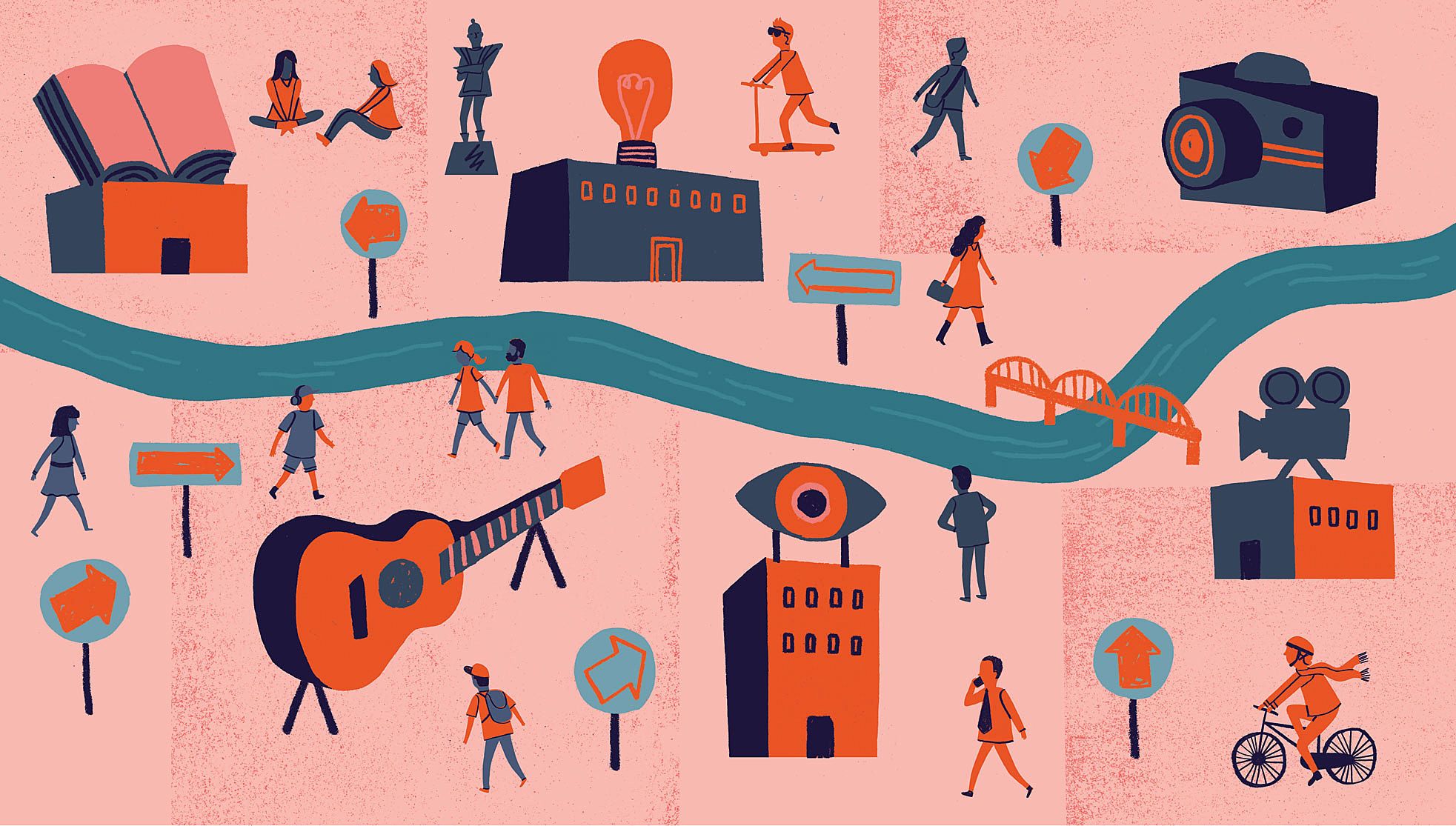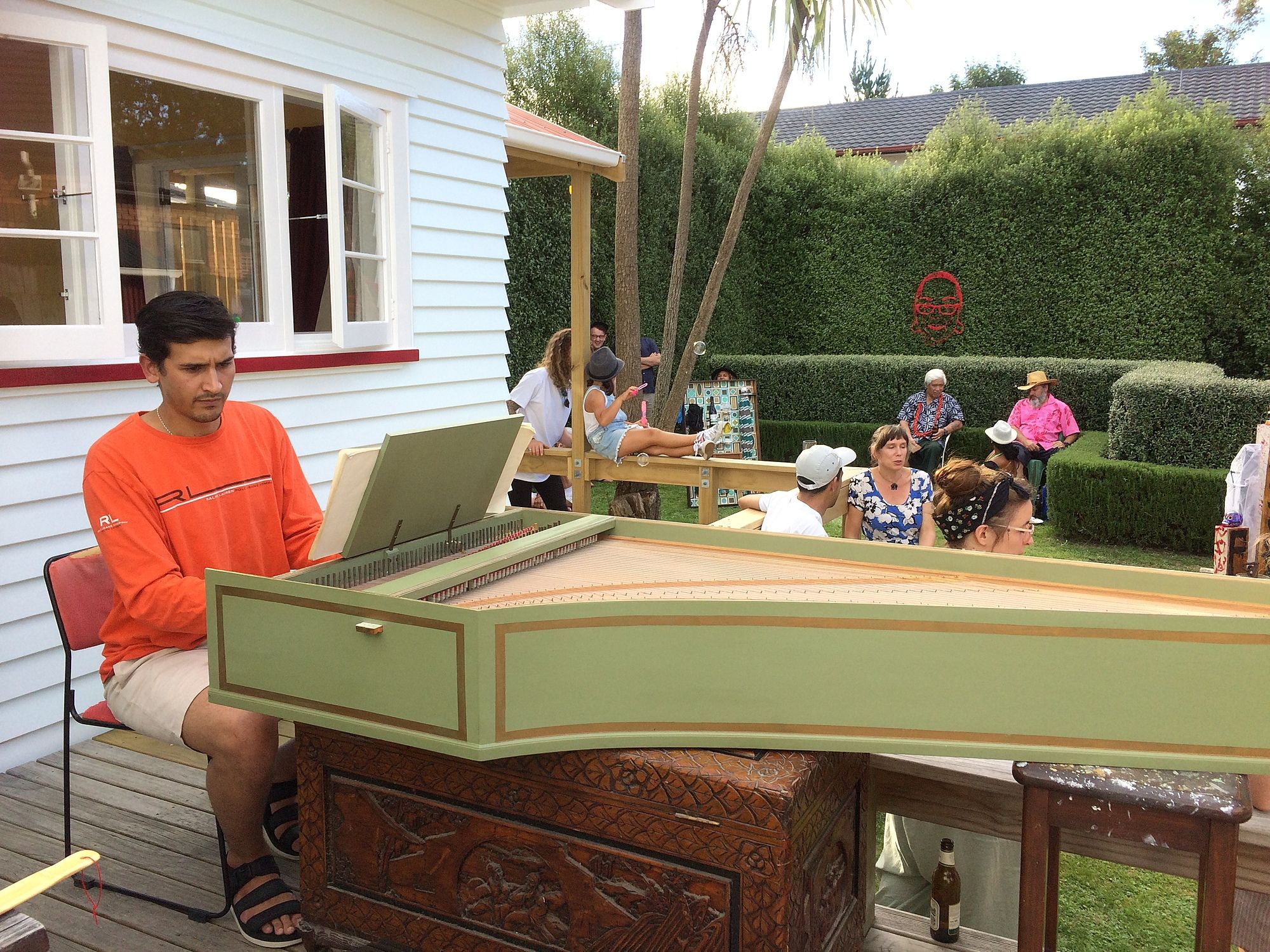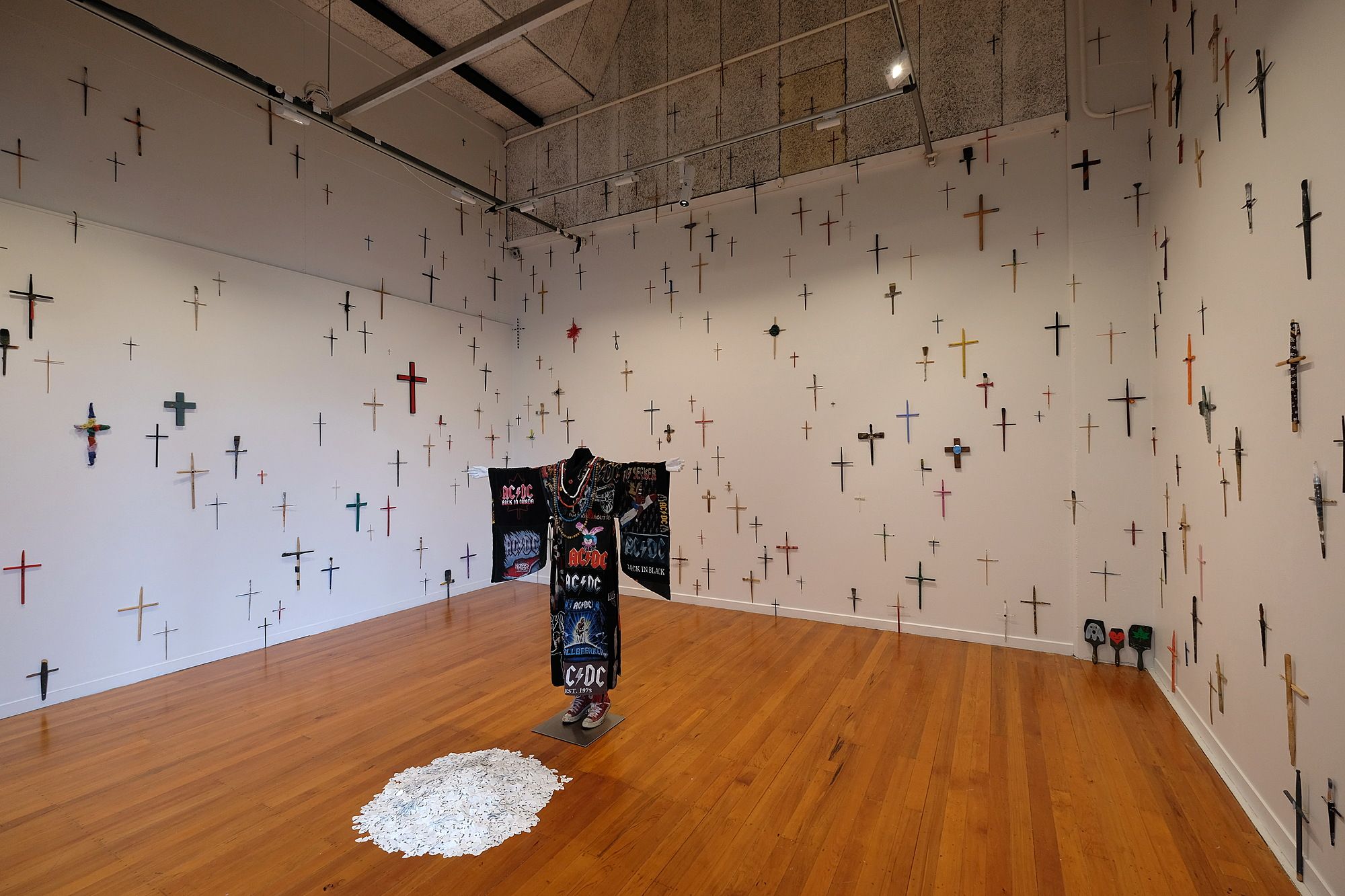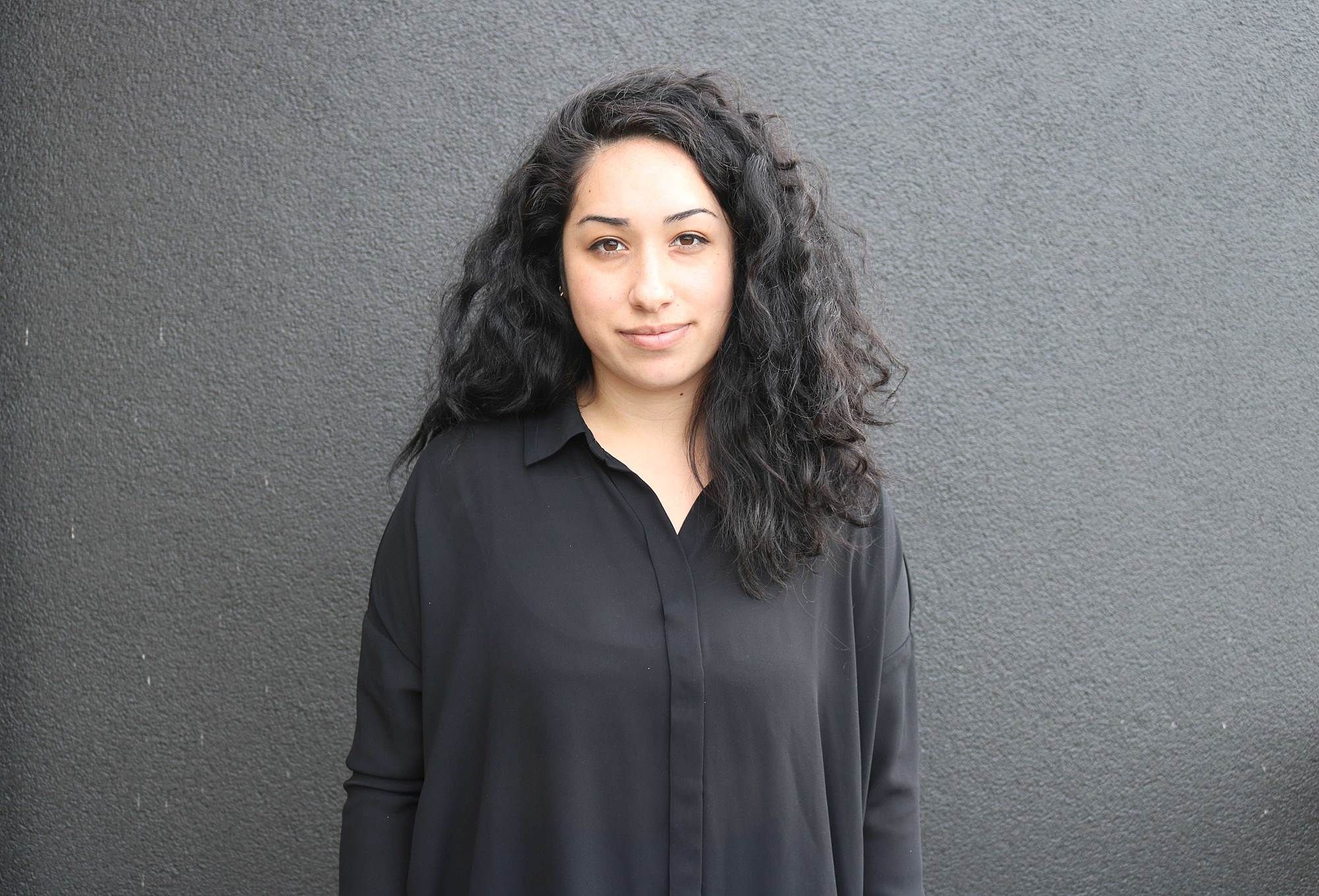Dull Backwater or Creative Centre? Searching for the Real Hamilton Arts Scene
Lana Lopesi investigates the creative pulse of an often-overlooked urban centre.
Lana Lopesi investigates the creative pulse of an often-overlooked urban centre.
Growing up in Tāmaki Makaurau Auckland, I always saw Kirikiriroa Hamilton as a bit of a wasteland really, a pimple on the side of the big city. And yet that’s not the reality I’ve seen recently.
One of my first and most memorable trips to Kirikiriroa was as a fresh university student, sneaking into the halls of residence at the University of Waikato to briefly visit friends (guests are not allowed) – a visit which saw me extremely hungover on the bus ride back home. More recently, though, my trips to Hamilton have been much more respectable. In my professional capacity as an art writer and (occasional) curator, I have brought overseas artists down to meet with key people from the creative community who happen to live in Hamilton; I have come down to run a workshop at Creative Waikato, where an overwhelming number of people turned up; and, on my most recent trip, I came to deliver a talk at the Hamilton Gardens Arts Festival, where I saw a different side of the city again – one which was full of whānau and arts activities.
Hamilton as a thriving – albeit underrated – arts centre is a stark contrast to the Hamilton which I always assumed it to be; the one that gets such a hard time on radio and TV. To find out more, I asked a number of key players what makes the arts in Kirikiriroa thrive.
*
Leafa Wilson, Curator Art at Waikato Museum Te Whare Taonga o Waikato and also an artist in her own right, has called Kirikiriroa home for many years now. “I am not certain what breeds and fosters creativity here, but art seems to be part of the community's heart,” says Wilson. She reminds me of the deep creative traditions in Kirikiriroa. Waikato, home to Tainui, is also home to the Kīngitanga (Māori King Movement), which was founded in 1858 with the aim of uniting Māori under a single sovereign. Acknowledging this, Wilson emphasises that “the very first artists here were Maaori and the carving tradition has been maintained through the King’s carvers at Waahi Paa. Also the expert weavers of the Hetet and Te Kanawa dynasty have their home in Waikato King Country, with Rangimarie Hetet and Diggeress Te Kanawa producing amazing weaving feats that are continued by Dr Kahutoi Te Kanawa and other members of their whanau.”
Other local art histories are also found within the Waikato Society of Arts, established by Ida Carey and Adele Younghusband in 1934. “To date, they have been the drivers for the likes of exhibitions and salons in the early days as well as the establishment of art competitions and art courses available for anyone to attend,” says Wilson. Arts programmes offered by Te Wananga o Aotearoa and University of Waikato, as well as School of Media Arts, Waikato Institute of Technology, SANDZ Gallery and Waikato Society of Arts also help to develop and keep national and local artists as students and lecturers.
I think that it will be harder in future for people to dismiss Hamilton as a dull backwater – it never really has been, it's just that it hasn't been obvious to outsiders.
Beyond people and institutions, there are also a number of hubs, which not only provide space to present art but also help keep artists connected. Waikato Museum Te Whare Taonga o Waikato is the largest exhibition space; it presents its own collection and exhibits taonga alongside contemporary art and social history. Just up the road are two university galleries: Calder and Lawson Gallery, run by the University of Waikato, and RAMP Gallery at the School of Media Arts. These spaces sit alongside independent galleries such as Tacit Gallery, Skinroom and Freit Contemporary; and commercial spaces such as Aesthete Gallery and Weasel. The Meteor Theatre plays a role in showcasing performing arts to the city. The city also boasts a range of festivals, including Boon Street Art Festival, RAMP Festival (formally Spark) and Hamilton Gardens Arts Festival. That’s not a bad offering. Not bad at all.
Bronwyn Bent, Co-Director of the Hamilton Gardens Arts Festival, grew up in Hamilton and is now back to run the festival. Bent considers places like The Meteor Theatre exciting, because they are “providing a home for artists, and providing a space for both artists and audiences to go out and find each other. I think this will just keep happening, and I think that it will be harder in future for people to dismiss Hamilton as a dull backwater – it never really has been, it's just that it hasn't been obvious to outsiders.”
Karl Bayly, who founded artist-run projects PILOT, Casbah and Free Parking Space, says the heart of Hamilton’s art community exists within its artist-initiated spaces. Spaces like PILOT, Casbah and Free Parking Space were started at a time when Hamilton had what Bayly describes as “a lack of both public and private showing spaces,” which meant that “artists, curators and anyone interested in facilitating the arts were driven to create their own space.” The importance of this start-it-yourself culture is clear from the long history of artist-run initiatives in the city, including Platform 01, New Friends Gallery, Ariki Gallery, Draw Ink, Pilot, OLGA and now, Weasel, Tacit and Skinroom.
in a place like Hamilton there also seems to be more freedom for younger artists to just give something a go
Artist-run spaces, which by nature are short-term projects generally lasting two years or so, are traditionally the places where young artists at the end of art school or freshly emerged cut their teeth. In many centres, however, increasingly unaffordable housing costs have made this model difficult to achieve, with young artists either having to rely on parental support or come up with creative solutions to make it work. But in Hamilton, the situation is brighter. As Bayly notes, “The city’s ever-changing infrastructure has also affected the amount of available spaces. With the arrival of [industrial and retail suburb] Te Rapa, the CBD essentially evacuated people and retail, which meant that there was a lot of unused property, which cost-wise makes the potential of starting new spaces much more accessible.”
But it’s not just an issue of cost – in a place like Hamilton there also seems to be more freedom for younger artists to just give something a go. Bent traced the snobbery that exits in New Zealand towards regional and rural areas back to colonial cringe; which has somehow transposed itself into a general feeling that smaller, rural places are boring and larger, urban ones aren’t. However, rather than seeing this as a negative, Bent suggests, “…it can be freeing when you’re in a situation where expectations are low; you can just get on and make work. There’s less pressure to measure up to something or someone else so you can just concentrate on doing your thing – the mushrooms growing in the dark metaphor – which means that people have more freedom to follow their own creative impulses. There are fewer people to tell you you're doing it ‘wrong’.” Wendy Richdale, Curator at RAMP Gallery, agrees. “In a city this size, you see people being brave and trying things out, learning from their mistakes and trying again.”
In part, it’s this DIY culture that has enabled Wilson to develop her uniquely multifaceted career as not only the Curator Art at Waikato Museum but also as a practising artist under the name OLGA. Arguably, in some other, larger places you may be forced to choose one thing – multidisciplinary artist or museum curator – with financial and time pressures making it too difficult to develop both. For Wilson, however, they’re inseparable. The impetus “to test art” is her driving force.
An amorphous project, OLGA is simultaneously the name Wilson uses as an artist, an ongoing project and a roaming project space. For Wilson, OLGA is the “only way to create outside of all the conventions of the gallery and art space and to make it as broadly accessible to as many different people as possible.” She continues, “The reason too that I have to make [the] concept [of OLGA] concrete is also just my own attempt at destabilising (even if only in a tiny way) the systems of art that have largely left people like me out of the art conversation. So at the very least, I am talking to myself…who cares? Nobody.”
While Wilson plays it somewhat cool about the contributions of her thinking and art making to a place like Hamilton, Richdale acknowledges that OLGA, which has “been around for a long time in different guises,” offers a history for others to “continually build upon.”
*
While Wilson, Bent, Bayly and Richdale make Hamilton seem like a land of opportunity, there are of course difficulties, too. Bayly commented, “Building an audience was the biggest challenge. I think there was one other artist-run space when I started, but it ended shortly after, so trying to create traction without there being much was pretty difficult.”
For Bent, who is running a ticketed festival, audiences take on a whole other level of importance. “People are a lot more cautious with shows in which they don’t know the performer or the show, so we have to try and do more talking about why we think a show is worth someone’s time. There's also a lot of price sensitivity in terms of how much people are prepared to spend on a ticket – this isn't unique to Hamilton but it’s noticeable, and again, I think that goes back to the fact that if you're only going to see a show a few times a year you understandably want to make sure it's worth it.”
Wendy Richdale, Curator at RAMP Gallery, admits that while art audiences are difficult to pin down in Hamilton, galleries like (dealer gallery) Weasel are living proof that there is a hunger there. “People want to come out and have a good time so do turn up.” She continues, “We have run an arts festival, Ramp Festival (formerly known as Spark Festival), for over 20 years and it’s still being supported and going strong. Also the Meteor Theatre in the last few years was gifted back to be community run after languishing in council hands. It appears to be going from strength to strength and has a mix of local and travelling theatre, music and happenings.”
I think there is some truth to what Wilson calls out as us larger centres being too busy navel gazing to ever notice the strong pulse in Waikato. It’s easy to fall into the trap of comparing Hamilton with other places, but for Wilson, there’s a tiredness in the constant comparison places like Hamilton face to larger cities
Another challenge for Bent is to make sure that the HGAF is “a festival of the Waikato, not just a festival that could be anywhere else in the world.” Despite the fact that “funding resources are scarcer in Hamilton,” making it hard to pull together the resources to support the development of new shows, when they do relate directly to the Waikato region they seem to do incredibly well. One example is Flowing Water (2018), which was a contemporary opera telling a story of the Waikato region. “It had a really enthusiastic response in terms of people going along,” says Bent.
Another challenge seems to be how to encourage new audiences to come to things where they don’t actually know what they are missing. Richdale thinks they are missing a vital tool to connect audiences to audiences and audiences to art, “now that newspapers aren’t read by everyone and have dropped ‘what’s on’ guides and reviews, getting the message out beyond your bubble can be a challenge.”
*
I think there is some truth to what Wilson calls out as us larger centres being too busy navel gazing to ever notice the strong pulse in Waikato. It’s easy to fall into the trap of comparing Hamilton with other places, but for Wilson, there’s a tiredness in the constant comparison places like Hamilton face to larger cities. Wilson says the makers in Kirikiriroa are interested in “making our own scene ‘pop’ – not to compete with other cities, but rather focusing on the strengths already present.”
Of course, the creative scene in Hamilton is intertwined with other nearby creative communities in Te Awamutu, Cambridge, Whaingaroa (Raglan) and Ngāruawaahia, for example, making the creative communities not necessarily Hamilton-specific but uniquely Waikato. The smallness of Hamilton and its neighbours means that not only do people know each other but that smaller creative groups within their artforms merge to become part of the greater art community. “Knowing each other by face and often by name is an asset to this-size community,” says Wilson.
being able to conceive of an idea and make it happen is an exciting and privileged position to be in
This also came into play for Bent at this year’s HGAF. “The curator of our film programme is a wonderful woman called Andrea Haines. This year we asked if it would be possible to include some short films from local filmmakers as well, and she managed to get that sorted in about one day because she already had those established relationships.” Wilson continues, “We support each other as much as possible and we are able to slot into spaces where we feel most comfortable. I think that is a reason why our city’s art scene is never static.” Richdale calls this quality agility – “being able to conceive of an idea and make it happen is an exciting and privileged position to be in.”
Take Hamilton on its own terms, measure it by its own standards and you’ll find some great art. If you overlook it, that’s your loss – Hamilton’s creative pulse will keep beating regardless.
This piece is presented as part of a partnership with Creative Waikato Toi Waikato. They cover the costs of paying our writers while we retain all editorial control. Illustration by Gary Venn.






